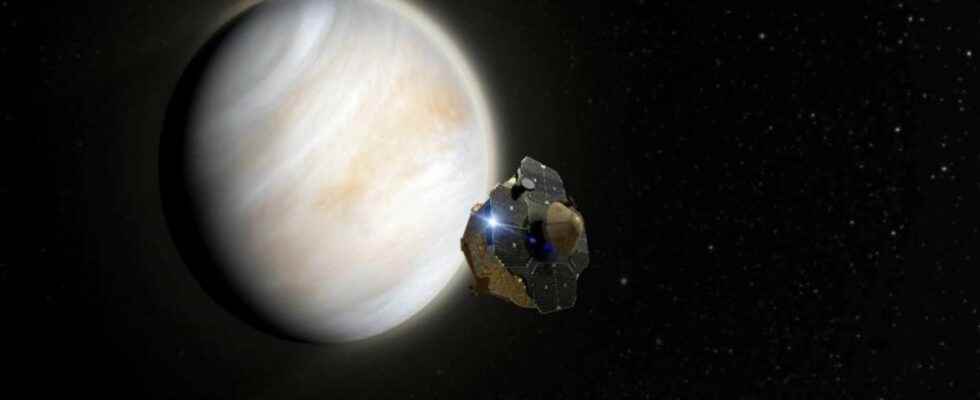In the era of New Space, Rocket Lab wants to open a new market, that of scientific exploration. low-cost “. This company, which successfully markets the small Electron launcher, has developed Photon, a small upper stage capable of interplanetary flight. An unprecedented technological bet that could well revolutionize the exploration of the close surroundings around the Earth.
You will also be interested
[EN VIDÉO] Magellan reveals the topography of Venus This visualization is a brief tour of the global terrain of the planet Venus as revealed by radar aboard the Magellan spacecraft. Terrain elevation is color coded, with blues and greens representing low elevations and reds representing high elevations. The two great “continents”, or highlands, Aphrodite Terra and Ishtar Terra, the Maxwell Montes mountain range and Maat Mons, a large currently dormant volcano, are highlighted.
If SpaceX wants to send humans on mars in order to colonize the Red Planet, RocketLab has less ambitious objectives but not devoid of scientific and technological interests. This American company of New Zealand origin, founded by Peter Beck, wishes to carry out a small exploration mission in the clouds of Venus in order to demonstrate that a private exploration mission at low cost, with rapid implementation and with an interesting scientific return, is possible using small launch vehicles.
Entirely financed by private funds, Venus Life Finder (VLF), that is its name, will be the first private exploration mission of Venus.
Rocket Lab, well established in the small payload launch market with its Electron launcherdeveloped the upper floor Photon which is betting on making space exploration accessible to “everyone” with exploration missions low-cost to the planets Mars and Venus, as well as around the Moon and in the terrestrial vicinity.
Professor Sara Seager discusses the Venus Life Finder missions, which will carry a robotic space payload partially funded by MIT alumni to Venus to search for signs of life in the planet’s atmosphere. https://t.co/VycSaCmJz5
— Massachusetts Institute of Technology (MIT) (@MIT) February 9, 2022
A stage capable of long-duration interplanetary cruises
This upper floor of Rocket Lab is a technological bet on the way to being successful. This stage has been designed for low orbit as well as for interplanetary missions with radiation-resistant avionics, navigation and communication technologies adapted to deep space as well as a propulsion system capable of restarting several times in orbit. This nifty little stage has already shown its capabilities with the successful launch of the capstone probe bound for the Moon on behalf of the Nasa. Also for NASA, Rocket Lab is preparing the launch of the Escapade mission (Escape and Plasma Acceleration and Dynamics Explorers) which will be launched to Mars in 2024.
To demonstrate the extent of the possibilities for using Photon, after the Moon and before Mars, Rocket Lab has decided to finance an unprecedented mission to Venus, the launch of which is scheduled for May 2023.
See if life exists in the clouds of Venus
Certainly, Venus Life Finder is not a mission of the same magnitude that NASA or ESA missions of several hundred kilograms. The Rocket Lab probe comes in the form of a cone spherical at half-angle of approximately 45 degrees and 40 centimeters in diameter. It carries a payload of only one kilogram whose sole instrument is an autofluorescent nephelometer (AFN). The probe communicates directly with Earth through an S-band communications link with a hemispherical antenna that returns scientific data captured during the descent and stored on board.
This rather surprising shape for a exploration probe owes nothing to chance. It was designed to take into account different stability characteristics in various flow regimes (hypersonic, transonic, subsonic, etc.). This form can also be explained by the fact that the easements necessary for interplanetary travel will be installed on the Photon stage. To explain the small size and low mass of VLF, it should be noted that the probe is sized in relation to the launch capabilities ofElectron which can place 225 kilos in low orbit (LEO low earth orbit) and 150 kilos in orbit sun-synchronous (SO, Sun Synchonous Orbit).
This mission is the first opportunity to directly probe particles in Venus’s cloud in nearly four decades. Its main objectives are to see if there are conditions of habitability in theatmosphere of Venus and its clouds and signs of life. Despite the mass constraints, debit of data and the limited time spent in the atmosphere of Venus, major scientific advances are possible, underlines the Rocket Lab team. Venus Life Finder should work only a few minutes in the atmosphere of Venus. The project team expects 330 seconds of observation which will take place between 45 and 60 kilometers of altitude and does not exclude a “bonus” with an operation of the probe even lower, a short time, and qu able to collect data and send it back to Earth.
—
SPECIAL OFFER: subscribe to our media for 3 months and receive the Mag Futura as a gift!*
*Offer valid for any new 3-month subscription to the “I participate in the life of Futura” offer on Patreon.
—
Interested in what you just read?
